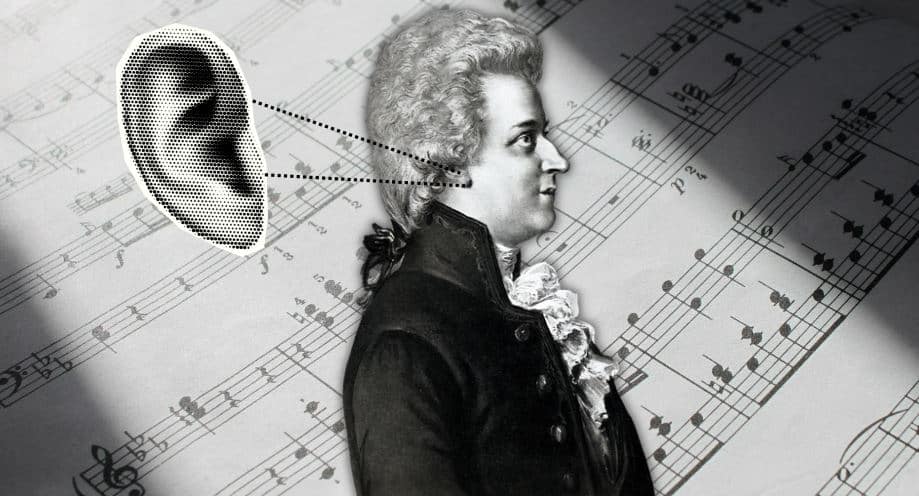
A watercolor drawing by Wolfgang Amadeus Mozart of his ear compared to an ordinary ear.
It is well known that Mozart had an ear for music. What is not so well known is that he also had a condition of the pinna that has, over the centuries, become known by the eponym “Mozart Ear”.
According to Yamashita et al. (2011), Mozart Ear is an auricular deformity characterized by a bulging appearance of the anterosuperior portion of the auricle, a convexly protruded cavum conchae, and a slit-like narrowing of the orifice of the external auditory meatus. Some have described it as a fusion of the cura of the anti-helix with the cura of the helix.
There is ambiguity surrounding the concept of “Mozart ear,” which remains incompletely defined due to the lack of a comprehensive description of the disease or its treatment. The anomaly, alternatively referred to as “Wildermuth Ear” after Hermann A. Wildermuth, the neurologist who identified the defect, is associated with Wolfgang Amadeus Mozart and his son Franz. This congenital deformity is characterized by a backward-oriented helix, leading to a protruding ante-helix and altering the ear’s appearance.
Mozart’s cause of death at the age of 35 remains a topic of speculation with no direct medical evidence, autopsy, medical records, or preserved remains available for conclusive information. Although various possible causes of death have been suggested, including poisoning among other reasons, none have been definitively proven. Some studies, notably Wang et al. (2001), have indicated a potential link between the Mozart ear malformation and renal urinary disease. Their review suggested an increased occurrence of clinically significant structural renal anomalies among individuals with this ear malformation compared to the general population. Izzedine et al. (2004) proposed that the association between ear and kidney anomalies during embryonic development may be attributed to mesodermal induction, impacting the normal differentiation of both organs.
While other suggested causes of Mozart’s demise are possible, Karhausen concluded
“the risk of having a congenital anomaly of the urinary tract was a hundred times higher with an external ear anomaly [such as Mozart’s ear] than in the general population.”
Unless significant new information is miraculously discovered, the exact cause of Mozart’s death will never be known, but renal/urinary tract disease is a distinct possibility.
References:
Wakin, D. (2010). After Mozart’s death, an endless coda. New York times. Retrieved December 16, 2014: https://www.nytimes.com/2010/08/25/arts/music/25death.html?_r=0
Stevenson, R. (2006). Human Malformations and Related Anomalies. Retrieved December 16, 2014:
Yamashita K., Yotsuyanagi T., Saito T., Isogai N., Mori H. & Itani Y. (2011). Mozart Ear: Diagnosis, treatment and literature review. Ann Plast Surg. 2011 Nov;67(5):547-50. Retrieved December 16, 2014: https://www.ncbi.nlm.nih.gov/pubmed/21587051
Wang, R., Earl, D., Ruder, R., & Graham, J. (2001). Syndromic anomalies and renal ultrasounds. Pediatrics. 2001 Aug;108(2). Retrieved December 16, 2014: https://www.ncbi.nlm.nih.gov/pubmed/11483842
Images:
Mozart, Wolfgang Amadeus, 1756-1791. Mein Ohr [und] ein gewöhnliches Ohr [My ear and an ordinary ear] : drawing, [n.p., n.d.] Water-color drawing; [n.p, n.d] 1 drawing : watercolor on paper: Retrieved December 16, 2014: https://kottke.org/13/07/mozart-had-weird-ears
About the author

Robert M. Traynor, Ed.D., is a hearing industry consultant, trainer, professor, conference speaker, practice manager and author. He has decades of experience teaching courses and training clinicians within the field of audiology with specific emphasis in hearing and tinnitus rehabilitation. He serves as Adjunct Faculty in Audiology at the University of Florida, University of Northern Colorado, University of Colorado and The University of Arkansas for Medical Sciences.
**this piece has been updated for clarity. It originally published on December 16, 2014







Is this your article Mr. Traynor?
https://www.myhearcare.com/mozart-ear-does-it-explain-the-great-composers-untimely-death/
Yes, it is original content put on this site. Thanks to your query, we’ve discovered that it has been republished elsewhere without attribution or permission. We are addressing that.
Yes this is my original content